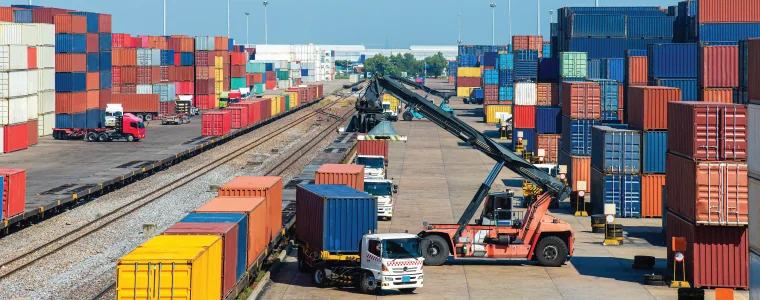The movement of goods between different modes of transportation (such as ships, trucks, and trains) and to and from ports, warehouses, and distribution centers is called drayage.
Drayage services play a crucial role in international trade and global supply chains, with broader implications that extend beyond just the physical movement of goods. For example, drayage operations can influence global trade patterns, including the choice of trade routes, transportation modes, and distribution strategies. They can also have significant environmental implications and can help mitigate risks in global supply chains, such as delays, disruptions, and security threats.
By understanding and optimizing drayage operations, businesses can improve their competitiveness, sustainability, and resilience in the global marketplace. Let’s take a closer look at how drayage connects to the wider supply chain network.

Drayage in Modern International Trade
While drayage is usually thought of as a ‘local’ service, it actually plays a key role in international trade, as it facilitates the movement of goods across borders and customs.
Here’s a detailed look at its role:
- First and Last Mile Connectivity: Drayage bridges the gap between long-haul transportation (such as ships, trains, or planes) and local distribution networks. It ensures that goods are efficiently transported from ports, rail yards, or airports to warehouses, distribution centers, or retail stores, and vice versa.
- Efficiency and Cost-Effectiveness: Drayage helps in optimizing transportation routes and modes, reducing empty miles, and improving the overall efficiency of the supply chain. By consolidating and optimizing loads, drayage providers can help reduce costs for shippers and carriers.
- Flexibility and Responsiveness: Drayage services offer flexibility and responsiveness in handling changing demand and supply patterns. They can quickly adapt to fluctuations in transportation needs, such as seasonal peaks or unexpected disruptions, ensuring that goods are delivered on time.
- Integration with Intermodal Transportation: Drayage is an integral part of intermodal transportation, where goods are transported using multiple modes (such as ships, trains, and trucks) without handling the cargo itself. Drayage providers play a key role in ensuring smooth transitions between different modes of transportation.
- Customs Clearance and Regulatory Compliance: Drayage providers often handle customs clearance and regulatory compliance requirements, ensuring that goods comply with import/export regulations. This includes ensuring proper documentation, payment of duties and taxes, and adherence to safety and security standards.
- Environmental Impact: Drayage can have a significant environmental impact, especially in terms of emissions and air quality. By promoting more sustainable practices drayage providers can help reduce the environmental footprint of global supply chains.
- Supply Chain Visibility and Traceability: Drayage services provide visibility and traceability in the supply chain, allowing shippers and carriers to track the movement of goods in real-time. This visibility is essential for effective supply chain management and inventory control.
Drayage is a complex and challenging sector, facing issues such as congestion, regulations, labor shortages, and environmental concerns. The future of drayage is likely to be shaped by several factors, such as the demand for faster and more efficient delivery, the need for more sustainability and compliance, and the availability of new technologies and innovations. Drayage providers will need to adapt and innovate to cope with the changing and competitive trade landscape.
Innovative Technology for Contemporary Problems
The modern-day impact of technology and innovation on this industry is significant, and for companies looking to partner with a drayage provider, it is important to consider the benefits of technology and innovation in this industry.
Some examples of technological innovations that are transforming the drayage industry are GPS tracking, electronic logging devices, automated booking platforms, blockchain-based smart contracts, and autonomous vehicles.
Technology and innovation can help improve the efficiency, safety, visibility, and sustainability of drayage operations, which can result in lower costs, higher customer satisfaction, and better environmental performance.
For example,
- autonomous trucks, like this one from Daimler Truck, can operate around the clock, optimize routes, and communicate with other vehicles and infrastructure,
- robotics can assist with loading and unloading containers,
- artificial intelligence can provide real-time data and insights for better decision making,
- blockchain can enable secure and seamless data sharing and transactions among different parties involved in drayage,
- and the Internet of Things can provide connectivity and visibility across the entire drayage process.
Technology and innovation are essential for the drayage industry to cope with the changing and challenging trade environment. Companies should evaluate the technological capabilities of their potential 3PL or drayage partners and select the ones that can offer the best solutions for their specific needs.
Conclusion
Drayage is a vital and dynamic part of the international trade and logistics industry, connecting ocean freight with the inland transportation network.
The future of drayage in international trade is both exciting and uncertain, as the industry faces many opportunities and challenges.
Drayage providers that prioritize agility, responsiveness, and forward-thinking will not only survive, but excel, in the global trade arena. Collaboration with stakeholders like shippers, carriers, ports, terminals, and regulators should be fundamental to their strategy, creating a more efficient and sustainable drayage ecosystem.
Adhering to these principles will ensure long-term success and relevance in the international trade and logistics industry.
